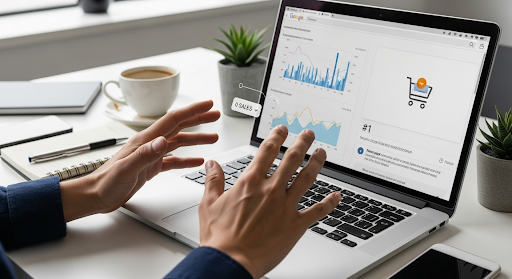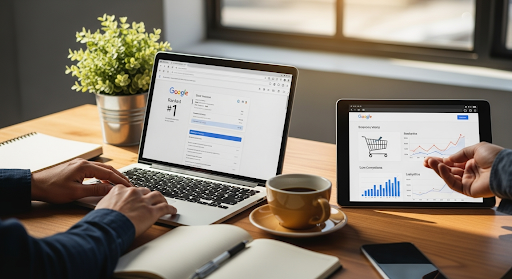Many businesses chase the top spot on Google. You might think it guarantees more sales, but it doesn’t. According to Ahref’s study, even 96.55% of content doesn’t get traffic, even if you ranked #1 on the search page. The truth is simple: Google Ranking vs Sales is not the same thing.
Ranking high brings visibility. But sales depend on your ability to guide visitors and earn their trust. The right search intent, brand authority, and great user experience all impact your sales.
In this article, you’ll learn why traffic doesn’t always convert and how you can convert your traffic into sales.

Google Ranking vs Sales: Why Ranking #1 Always Brings Sales and How to Overcome It
Here are the reasons you should keep in mind why ranking #1 on Google doesn’t always mean it can bring you sales. We also explained how you can overcome this situation.
Ranking Brings Traffic, But Traffic Doesn’t Equal Conversions
Ranking high will bring more visitors to your website. But traffic doesn’t always mean money in your pocket.
If your website doesn’t guide visitors toward taking action, they’ll leave quickly. A weak landing page experience creates a poor user experience (UX) and impression. Missing or unclear calls to action (CTAs) cause people to hesitate.
This is where conversion rate optimisation (CRO) comes in. CRO ensures visitors understand their next steps. Without it, you’ll see a high bounce rate. That means people click away without buying, no matter how high you rank.

Ranking With Wrong Keywords Won’t Bring Sales
If you are ranked with the wrong keyword, you may get traffic. But ultimately, you won’t get any sales.
- If you are a cleaning service provider and write content on travel, you may rank on top. However, when the audience clicks through your content, you will get traffic, but no sales for your business.
- Also, if you are a local service provider in Brisbane, but rank for the keyword “best cleaning service in the world” worldwide, you won’t get sales.
If you rank for the wrong terms, you’ll get the wrong audience. More clicks, but fewer customers. That’s why keyword relevance is more important than just being number one.
Aside from these, informational keywords attract people who only want knowledge. They aren’t shopping. For example, someone searching “what is SEO” is possibly doing research.
Commercial intent keywords attract people closer to buying. For instance, “SEO services in Brisbane” shows they’re looking for a provider.

Most People Don’t Convert on the First Visit- and How Brand Authority Helps
Even if you reach the right audience, most visitors won’t buy on their first visit. People need time and multiple touchpoints before making a decision.
Think about your own buying habits. Do you usually purchase from the first website you land on? Probably not. You compare, read reviews, and wait until you trust the brand.
That’s why brand authority is so important. Visitors need to feel confident that you can deliver before they act. A strong sales funnel should reflect this reality.
From awareness to decision, every step should guide users with helpful content, retargeting, and clear offers.
A study by BREVET shows that 80% of sales need 5 follow-up calls. So, you need to have a follow-up strategy to keep your targeted audiences engaged.
- You can keep your visitors updated through emails with discounts and free guides.
- Retarget ads to bring them back to your website.
Over time, consistent messaging, reviews, and professional branding build credibility. When customers see your business multiple times and find answers to their questions, they start to trust you.
In fact, people often choose a trusted brand ranked lower over an unknown brand sitting at #1.
This combination—understanding that most people don’t convert right away and focusing on building brand authority—is what turns one-time visitors into loyal customers. It ensures your traffic doesn’t just click but actually commits.

Vanity Metrics Don’t Bring Sales; Aligning Ranking With Business Goals Does.
High rankings and clicks are exciting. But they are often vanity metrics, such as:
- Search engine rankings.
- Website traffic (how many people visited).
- Social media likes, shares, or followers.
These metrics make you feel good, but they don’t show if you’re making money or reaching your business goals.
The opposite of vanity metrics are actionable metrics—numbers that connect directly to growth. For example:
- Conversion rate (how many visitors became customers).
- Leads generated.
- Sales revenue.
- Return on investment (ROI).
Your real focus should be on business goals. Do you want more leads, phone calls, or actual sales? That’s where you should measure success.
Look at your marketing ROI (return on investment). A top ranking is useless if the cost outweighs the sales. Use analytics to see where visitors drop off. Then adjust your strategy.
Qualified leads and paying customers are the true measure of success, not just traffic numbers.

📌 What Actually Gets You Sales (Beyond SEO)
SEO brings traffic, but real sales depend on what happens after visitors arrive. Here’s an overview of the whole discussion you should keep in mind to bring sales, not just ranked #1.
- Make a converting website: Clear messaging, strong CTAs, simple navigation, and trust signals build confidence.
- Target the right audience: Use buyer-intent keywords to attract visitors ready to take action.
- Follow up with leads: Email captures, retargeting ads, and helpful content re-engage people who didn’t buy right away.
- SEO is only the start: Traffic is step one—conversions happen when you guide and nurture visitors effectively.
Final Thought
Google Ranking vs Sales doesn’t always equal. Success comes from pairing strong rankings with clear business goals, conversion-focused design, and a seamless customer journey.
That’s where SEO 4Business Group makes a difference. They don’t just help you rank — they build strategies that actually drive results. From creating a custom website to running targeted digital marketing and SEO campaigns, their team focuses on growth that matters. With the right mix of visibility, user experience, and sales-driven tactics, they can help your business turn clicks into paying customers.
ALSO READ: Dynamics 365 for Sales vs. Sales Professional: What’s the Difference?






